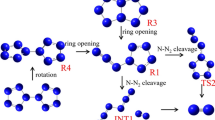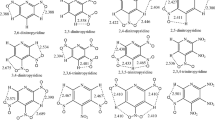Abstract
1,3-Diazido-2-methyl-2-nitropropane (DAMNP) is a newly synthesized azido compound and may be a potential candidate of the plasticizer of propellants. For better understanding its properties, the molecular conformations, electronic structure, IR spectrum, thermodynamic properties, pyrolysis mechanism, and specific impulse (I S) were studied using the B3LYP/6-31++G** method of density functional theory (DFT). The electronic structure of DAMNP was analyzed by the natural atomic charges, bond orders, donor–acceptor interactions, and molecular electrostatic potential (MEP). Results show that the main contributions to the highest occupied molecular orbital and the lowest unoccupied molecular orbital are from –N3 and –NO2, respectively. The most negative area on the MEP locates at the O atoms of –NO2, which agrees with the atomic charges distributions. The pyrolysis mechanism was investigated by considering three possible bond dissociations (C–N3, C–NO2, and N–N2). Results show that the pyrolysis of DAMNP starts from the rupture of N–N2 finished cooperatively via the H-transfer process to eliminate N2. The lowest energy needed for pyrolysis is 165.13 kJ mol−1. To verify the reliability of the method, the organic azido compound CH3N3 was also considered. DAMNP has a slightly higher thermal stability than CH3N3. However, using DAMNP to replace the plasticizer nitroglycerin of the nitramine modified double-base propellant leads to a decrease in I S. Therefore, whether DAMNP can be really used as a plasticizer or not is worth further considerations.








Similar content being viewed by others
References
Ghosh K, Athar J, Pawar S, Polke B, Sikder A (2012) Synthesis, characterization, and rheological evaluation of 1,3-diazido-2-ethyl-2-nitropropane as an energetic plasticizer. J Energ Mater 30:107–123
Ghosh K, Pant CS, Sanghavi R, Adhav S, Singh A (2008) Studies on triple base gun propellant based on two energetic azido esters. J Energ Mater 27:40–50
Kumari D, Balakshe R, Banerjee S, Singh H (2012) Energetic plasticizers for gun & rocket propellants. Rev J Chem 2:240–262
Stefan E, Latypov N, Goede P, Yiewwang L, Raymond YG-Y (2012) Energetic plasticizers based on gem-dinitrodiols. J Energ Mater 30:324–334
Pant CS, Wagh RM, Nair JK, Gore GM, Venugopalan S (2006) Synthesis and characterization of two potential energetic azido esters. Propellants Explos Pyrotech 31:477–481
Wang YL, Ji YP, Li PR, Chen B, Lan Y (2010) Synthesis of 2-methyl-2-nitro-1,3-diazido-propane. Chin J Energ Mater 18:11–14
Weinhold F, Landis CR (2012) Orbital graphics: the NBOView orbital plotter. In: Discovering chemistry with natural bond orbitals. Wiley, Hoboken, pp 300–301
Glendening ED, Landis CR, Weinhold F (2012) Natural bond orbital methods. Wiley Interdiscip Rev Comput Mol Sci 2:1–42
Kohn W (1999) Nobel lecture: electronic structure of matter-wave functions and density functionals. Rev Mod Phys 71:1253–1266
Kohn W, Becke AD, Parr RG (1996) Density functional theory of electronic structure. J Phys Chem 100:12974–12980
Luther G (1990) In: Stumm W (ed) Aquatic chemical kinetics. Wiley, New York, pp 173–198
Becke AD (1992) Density-functional thermochemistry. II. The effect of the Perdew-Wang generalized gradient correlation correction. J Chem Phys 97:9173–9177
Becke AD (1993) Density-functional thermochemistry. III. The role of exact exchange. J Chem Phys 98:5648–5652
Lee C, Yang W, Parr RG (1988) Development of the Colle-Salvetti correlation-energy formula into a functional of the electron density. Phys Rev B 37:785–789
Zhang JY, Du HC, Wang F, Gong XD, Huang YS (2011) DFT studies on a high energy density cage compound 4-trinitroethyl-2,6,8,10,12-pentanitrohezaazaisowurtzitane. J Phys Chem A 115:6617–6621
Liu Y, Gong XD, Wang LJ, Wang GX, Xiao HM (2011) Substituent effects on the properties related to detonation performance and sensitivity for 2,2′,4,4′,6,6′-hexanitroazobenzene derivatives. J Phys Chem A 115:1754–1762
Wang F, Wang GX, Du HC, Zhang JY, Gong XD (2011) Theoretical studies on the heats of formation, detonation properties, and pyrolysis mechanisms of energetic cyclic nitramines. J Phys Chem A 115:13858–13864
Politzer P, Murray J, Grice M, Sjoberg P, Olah G, Squire D (1991) In: Olah GA, Squire DR (eds) Chemistry of energetic materials. Academic Press, San Diego, pp 77–92
H. Liu FW, Wang GX, Gong XD (2013) Theoretical studies on 2-(5-amino-3-nitro-1,2,4-triazolyl)-3,5-dinitropyridine (PRAN) and its derivatives. J Phys Org Chem 26:30–36
Liu H, Wang F, Wang G, Gong X (2013) Theoretical studies on the structures, densities, detonation properties and thermal stability of 2,4,6-trinitropyridine N-oxide (TNPyO) and its derivatives. Mol Simul 39:123–128
Frisch MJ, Trucks GW, Schlegel HB, Suzerain GE, Robb MA, Cheeseman JrJR, Montgomery JA, Vreven T, Kudin KN, Burant JC, Millam JM, Iyengar SS, Tomasi J, Barone V, Mennucci B, Cossi M, Scalmani G, Rega N, Petersson GA, Nakatsuji H, Hada M, Ehara M, Toyota K, Fukuda R, Hasegawa J, Ishida M, Nakajima T, Honda Y, Kitao O, Nakai H, Klene M, Li X, Knox JE, Hratchian HP, Cross JB, Bakken V, Adamo C, Jaramillo J, Gomperts R, Stratmann RE, Yazyev O, Austin AJ, Cammi R, Pomelli C, Ochterski JW, Ayala PY, Morokuma K, Voth GA, Salvador P, Dannenberg JJ, Zakrzewski VG, Dapprich S, Daniels AD, Strain MC, Farkas O, Malick DK, Rabuck AD, Raghavachari K, Foresman JB, Ortiz JV, Cui Q, Baboul AG, Clifford S, Cioslowski J, Stefanov B, Liu G, Liashenko A, Piskorz P, Komaromi I, Martin RL, Fox DJ, Keith T, Al-Laham MA, Peng CY, Nanayakkara A, Challacombe M, Gill PMW, Johnson B, Chen W, Wong MW, Gonzalez C, Pople JA (2004) Gaussian 03, Revision B.05. Gaussian, Wallingford
Salathiel WM, Curl R Jr (1966) Microwave spectrum of methylazide. J Chem Phys 44:1288–1291
Scott AP, Radom L (1996) Harmonic vibrational frequencies: an evaluation of Hartree-Fock, Møller-Plesset, quadratic configuration interaction, density functional theory, and semiempirical scale factors. J Phys Chem 100:16502–16513
Wong MW (1996) Vibrational frequency prediction using density functional theory. Chem Phys Lett 256:391–399
Thompson WT, Fletcher WH (1966) Force constants of hydrazoic acid and methyl azide. Spectrochim Acta 22:1907–1921
Hill TL (1960) In: Wesley A (ed) An introduction to statistical thermodynamics. Courier Dover, New York
Qiu LM, Ye DY, Wei W, Chen KH, Hou JX, Zheng J, Gong XD, Xiao HM (2008) DFT studies toward the design and properties of high-energy density hydrocarbon fuel. J Mol Struct (Theochem) 866:63–74
Wang GX, Gong XD, Du HC, Liu Y, Ming XH (2011) Theoretical prediction of properties of aliphatic polynitrates. J Phys Chem A 115:795–804
Zhang JY, Du HC, Wang F, Gong XD, Huang YS (2012) Theoretical investigations of a high density cage compound 10-(1-nitro-1,2,3,4-tetraazol-5-yl)) methyl-2,4,6,8,12-hexanitrohexaazaisowurtzitane. J Mol Model 18:165–170
Xia QY, Xiao HM, Ju XH, Gong XD (2003) Ab initio study on the intermolecular interaction of methyl azide dimers. J Energ Mater 11:116–122
Klapötke TM (1997) Recent developments in the chemistry of covalent azides. Chem Ber 130:443–452
Ju XH, Wang ZY, Yan XF, Xiao HM (2007) Density functional theory studies on dioxygen difluoride and other fluorine/oxygen binary compounds: availability and shortcoming. J Mol Struct (Thoechem) 804:95–100
Selvam L, Vasilyev V, Wang F (2009) Methylation of zebularine: a quantum mechanical study incorporating interactive 3D pdf graphs. J Phys Chem B 113:11496–11504
Scrocco E, Tomasi J (1973) In: Davison A, Dewar MJS (eds) New Concepts II. Springer, Berlin, pp 95–170
Lovelock JE, Lipsky SR (1960) Electron affinity spectroscopy—a new method for the identification of functional groups in chemical compounds separated by gas chromatography. J Am Chem Soc 82:431–433
Weinhold F (1996) General introduction and installation natural bond orbital analysis programs, in Natural Bond Orbital Analysis Programs: NBO 5.0/5.G Program Manual. Madison, Wisconsin. pp. 1–23
Oyumi Y, Rheingold A, Brill T (1987) Thermal decomposition of energetic materials. 19. Unusual condensed-phase and thermolysis properties of a mixed azidomethyl nitramine: 1,7-diazido-2, 4,6-trinitro-2,4,6-triazaheptane. J Phys Chem 91:920–925
Brill T, Karpowicz R, Haller T, Rheingold A (1984) A structural and Fourier-transform infrared-spectroscopic characterization of the thermal decomposition of 1-(azidomethyl)-3,5,7-trinitro-1,3,5,7-tetraazacyclooctane. J Phys Chem 88:4138–4143
Quinto-Hernandez A, Wodtke AM, Bennett CJ, Kim YS, Kaiser RI (2010) On the interaction of methyl azide (CH3N3) ices with ionizing radiation: formation of methanimine (CH2NH), hydrogen cyanide (HCN), and hydrogen isocyanide (HNC). J Phys Chem A 115:250–264
Wang GX, Gong XD, Liu Y, Du HC, Xu XJ, Xiao HM (2011) Looking for high energy density compounds applicable for propellant among the derivatives of DPO with –N3, –ONO2, and –NNO2 groups. J Comput Chem 32:943–952
Acknowledgments
We gratefully thank the Research Fund for Natural Science Foundation of Jiangsu Province (No. BK20130755), the Doctoral Program of Higher Education of China (No. 20103219120014), and “Excellent Plan and Zijin Star” Research Foundation of NUST for their support of this work.
Author information
Authors and Affiliations
Corresponding author
Electronic supplementary material
Below is the link to the electronic supplementary material.
Rights and permissions
About this article
Cite this article
Yang, J., Yan, H., Zhang, X. et al. A theoretical prediction of the molecular and electronic structures, thermodynamic properties, and stability of 1,3-diazido-2-methyl-2-nitropropane (DAMNP). Struct Chem 25, 931–940 (2014). https://doi.org/10.1007/s11224-013-0364-4
Received:
Accepted:
Published:
Issue Date:
DOI: https://doi.org/10.1007/s11224-013-0364-4




